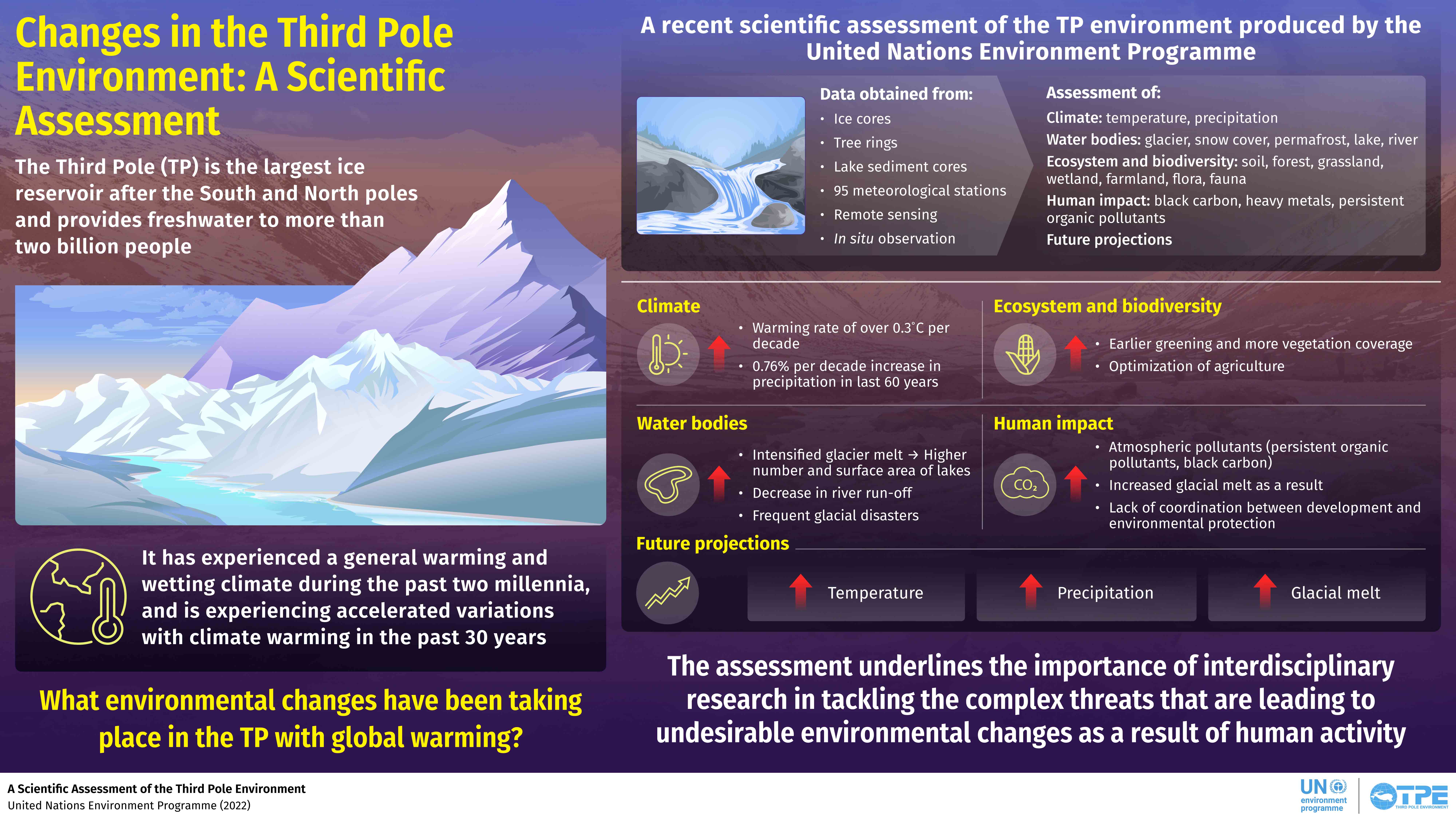The Third Pole, one of Earth’s most diverse ecosystems, is changing rapidly owing to climate change from human activity. In an attempt to raise awareness and put the problem into perspective, the
United Nations Environment Programme(UNEP) has recently published a scientific assessment of the Third Pole environment. This comprehensive report condenses the latest knowledge on the various aspects of the Third Pole, such as climate, water systems, biodiversity, and the impact of human activities.
Changes in the Third Pole Environment Credit: TPE
The Third Pole (TP), which encompasses the Tibetan Plateau and its surrounding mountain ranges, is the third largest reservoir of ice and snow after the North and South poles. Its 100,000 km2 of glaciers supply freshwater to thousands of lakes and rivers, sustaining the lives of over two billion people. The region is also home to some of Earth’s most biodiverse ecosystems.
However, a recent scientific assessment of the TP environment made by the UNEP has reavled significant changes in the region. The TP is one of the regions that are most vulnerable to climate change. Climate warming has posed a threat to the TP’s ecosystems and water cycles. Against this backdrop, the assessment has underscored the importance of mitigating the threats of climate change effects driven by human activity. Most notably, this is the first comprehensive assessment of the TP environment.
Published on 21 April 2022, the assessment has been produced by UNEP in cooperation with the UNEP-International Ecosystem Management Partnership, the
Third Pole Environment (TPE), and the Pan-Third Pole Environment. The report, involving the contributions of several authors, has been organized into four chapters.
Chapter 1 highlights the urgency of regional assessment of the TP environment and provides an overarching design of the report. The lead authors of this chapter are Prof. YAO Tandong, co-chair of TPE, and Prof. CHEN Deliang, with additional contributions from YANG Xiaoxin Yang and WANG Weicai.
This report presents the latest knowledge on the climate, freshwater bodies, ecosystems, biodiversity, land surface changes and human impact on the Third Pole, noted the authors. The authors point out that the warming rate in the TP is double the global average. This can drive undesirable environmental changes at the local and global levels.
Chapter 2 highlights the environmental changes in the TP that have occurred over the past 2000 years. The lead authors for this chapter are Prof. Lonnie G. Thompson, Dr. Xu Baiqing, and Dr. Arun Bhakta Shrestha. Additional contributions come from Dr. ZHANG Yangjian, Dr. Santosh Nepal, Dr. Jakob Friedrich Steiner, Dr. ZHAO Lin, Dr. Binita Phartiyal, and Dr. Shuaib Farhan.
Data derived from ice cores, lake sediment cores, and tree rings show that, since the 20th century, the warming and wetting of the TP has become more pronounced, reaching record-setting average temperatures and precipitation. The is due to an acceleration of the warming rate by 0.3 °C per decade, which far surpasses the global warming average.
This has led to a marked increase in glacier melt over the past few decades along with a rise in the surface area of lakes and river run-off. Together, these changes are causing natural disasters, such as ice collapses and glacial lake outbursts floods, to become more frequent, threatening local ecosystems and human lives alike.
Additionally, the TP has become greener, with more vegetation coverage and, in turn, a surge in agriculture and farming. However, invasive species, infrastructure projects, and climate change continue to be a threat to the TP.
Chapter 3 analyses the effects of human activities outside the TP on its environment. The lead authors, Prof. KANG Shichang and Dr. SHI Peng, point out that air pollutants, such as persistent organic pollutants and black carbon, make their way into the TP through various climate phenomena, leading to accelerated glacial melt. This is due to a lack of coordination between economic development of nearby regions and environmental protection. Additional contributions come from Dr. CHE Jing, Dr. SUN Hang, Dr. GONG Ping, Dr. Babar Khan, Dr. ZHANG Yulan, Dr. Bhupesh Adhikari, Dr. ZHANG Qianggong, and Dr. Siva Praveen Puppala.
Finally, chapter 4 provides future projections for the environmental changes in the TP. According to the lead authors, Dr. PIAO Shilong and Dr. Walter Immerzeel, the temperature and precipitation in the region would continue to rise, causing glaciers to melt and water bodies to expand, among other effects. The other contributing authors to this chapter are Dr. WANG Tao, Dr. YANG Wei, Dr. LIU Yongwen, and Dr. SU Fengge.
An increasing body of scientific research points to cascading crises that need to be addressed immediately. Now is the time to define humanity’s response to the mounting evidence of our deteriorating natural world, concluded the report.







